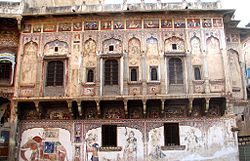Nawalgarh
| Nawalgarh | ||
|---|---|---|
|
|
||
| State : |
|
|
| State : | Rajasthan | |
| District : | Jhunjhunu | |
| Sub-district : | Nawalgarh | |
| Location : | 27 ° 51 ′ N , 75 ° 16 ′ E | |
| Height : | 390 m | |
| Area : | 18 km² | |
| Residents : | 63,948 (2011) | |
| Population density : | 3553 inhabitants / km² | |
| Nawalgarh - facade of a haveli | ||
Nawalgarh is a city with about 65,000 inhabitants in the Jhunjhunu district in the Shekhawati region in the northeast of the Indian state of Rajasthan .
location
Nawalgarh is about 142 km (driving distance) northwest of Jaipur at an altitude of about 390 m above sea level. d. M .; the Indian capital Delhi is about 270 km to the northeast. Nawalgarh has a train station on the Sikar - Jhunjhunu line . The climate is hot and - with the exception of the monsoon months from July to September - dry.
population
About 58.5% of the population are Hindus , about 41% are Muslims ; the other religious groups such as Jains , Sikhs , Christians and Buddhists play no role in the country. As is customary in northern India, the male population is around 10% higher than the female.
economy
The Shekhawati region is traditionally characterized by agriculture, with cattle breeding (sheep, goats, camels) playing a major role in the past. Because of the passing trade caravans, traders settled in the larger villages as early as the 17th and 18th centuries, but after the shift of trade to the ports of Surat , Bombay and the like. a. had to migrate. Tourism is only of minor importance.
history
For centuries, Nawalgarh was only a larger village, which only rose to become a city through the activities of Thakur Nawal Singh Ji Bahadur around the middle of the 18th century and was given a city wall with four gates. Due to the increase in caravan trade between India and the Middle East and Europe in the 18th and 19th centuries, the place had gained a certain importance. Merchants who had become wealthy settled there and built large residential and commercial buildings ( havelis ) that were richly decorated with paintings. After the British came to power , trade increasingly shifted to the seaports further south and the entire Shekhawati region was sidelined; the old trading houses were occupied by immigrants from the rural regions and fell into disrepair.
Attractions
- There are several old merchant houses distributed in the city (e.g. Anandi Lal Podar Haveli , Murarka Haveli , Bansidhar Bhagat Haveli , Chokhani Haveli , Seksaria Haveli , Bhagat Haveli , Podar Haveli , Chudi wali Haveli , Morarka Haveli , 8 Haveli etc.) Paintings with mostly popular religious themes ( Krishna and Radha or Rama and Sita ) date from the end of the 19th or beginning of the 20th century. Many havelis are in a ruinous state.
- Several Hindu temples , mostly built in the 19th or early 20th century, are also decorated with paintings: Shri Ramdev Ji Mandir , Shri Balaji Mandir , Lakshmi Narayan Mandir , Shri Gopinath Ji Mandir , Shri Bawari Wala Balaji Mandir , Shri Kalyan Ji Mandir , Gangamai Temple , Shri Ganesh Mandir .
- About 1 km outside of the city is the Roop Nivas Palace , built in the early 20th century and converted into a stylish hotel .


